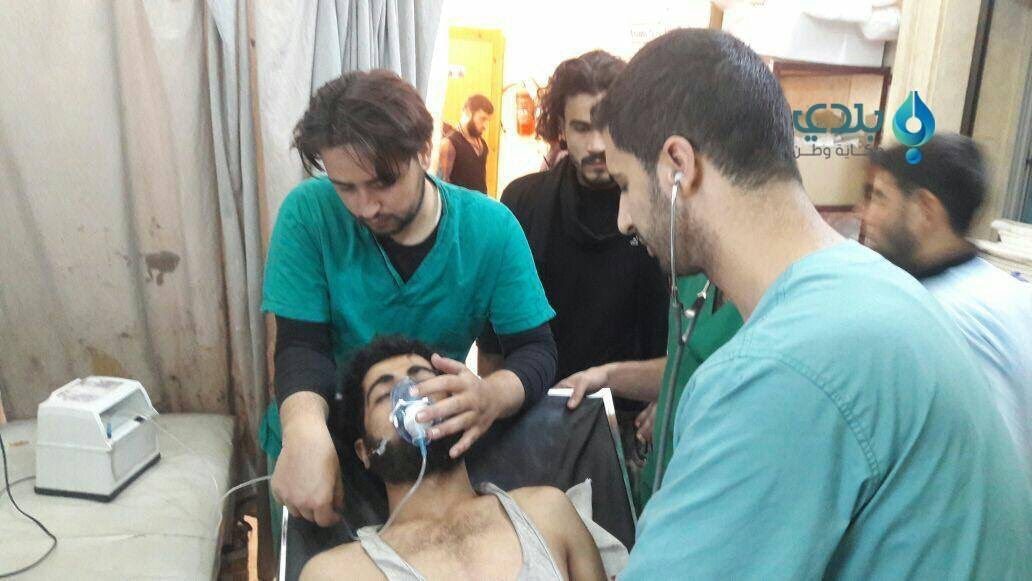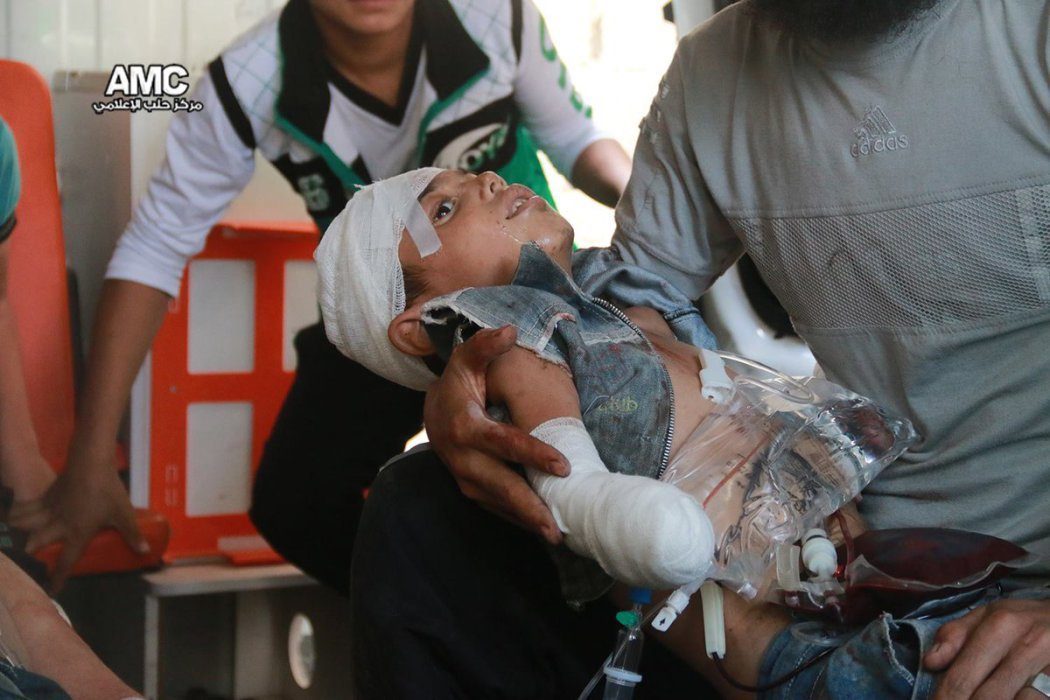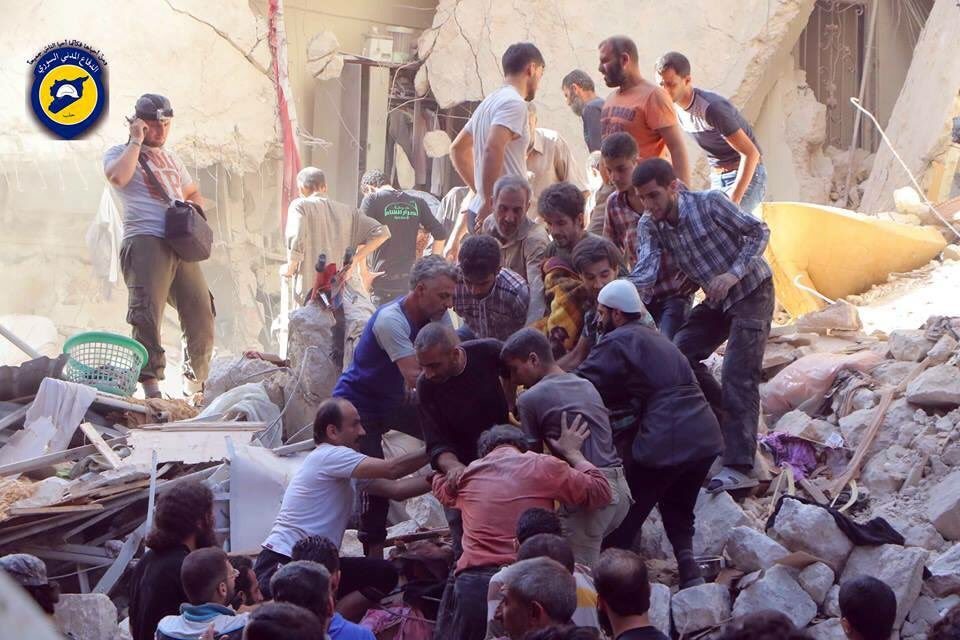
Syrian state media said militants had fired chlorine gas at a residential area of the regime-held western part of the Aleppo, al-Hamdaniya, as the rebel alliance was pushing forward in a new military operation to break siege on besieged parts of the city.
On Friday 29 October the rebel forces started a new military operation, employing heavy shelling and suicide car bombs, was mainly focused on the city’s western edge by rebels based in the countryside outside Aleppo. It included Jabhat Fateh al-Sham, a former affiliate of al Qaeda previously known as the Nusra Front, and groups fighting under the Free Syrian Army (FSA) banner.
Syrian rebels on Sunday kept up their shelling of regime-controlled areas of the city, killing at least seven people, including three children, state TV reported, and used car bombs and tanks to push into new territory in western areas. The Syrian regime claimed the opposition fighters used toxic gas.
Syrian state media said militants had fired shells containing chlorine gas at a residential area of the regime-held western part of the city, al-Hamdaniya. Rebels denied that, and said government forces had fired poison gas on another frontline.
Chlorine is an industrial chemical and was not part of the weapons stockpile that Syria agreed to give up in 2013.
The observatory said several civilians were reportedly suffering from breathing difficulties following the attack in al-Hamadaniyeh on Sunday. But Abdurrahman couldn’t not confirm or deny if this was due to use of toxins.
State media cited an Aleppo hospital director saying three dozen people – civilians and soldiers – had suffered suffocation in the alleged rebel gas attack, but did not report any deaths.
The Syrian state news agency Sana said 48 people were treated for breathing difficulties. State TV showed residents and medics wearing masks rushing people into a hospital.
Opposition fighters and the government have exchanged accusations of using chemical attacks on their respective areas.
A rebel spokesman dismissed government accusations they used gas. Idriss Raad, a member of Faylaq al-Sham rebel group, said the opposition did not possess such weapons and would not attack areas with its own supporters. “The rebel would not target his people,” he said in an exchange of messages.
The rebels said the army had shelled rebel-held Rashideen district with chlorine and shared videos purportedly showing victims with respiratory problems.
Chlorine-filled barrel bombs dropped on al-Rashideen, Aleppo by Assad regime have left many civilians suffocating & struggling to breathe. pic.twitter.com/9FRcx4hczi
— هادي العبدالله Hadi (@HadiAlabdallah) October 31, 2016
#معاذ : #Syria: Activists – 2nd chlorine attack in 2 days by regime forces near #Aleppo https://t.co/YtEplu8pON pic.twitter.com/7B8Lrz8FLc
— مـعـــاذ (@22_jussy) October 31, 2016
Those photos will not be seen on MSM.
The victims of the terrorists’ chemical attack on #Aleppo #Syria pic.twitter.com/LBVJuuyGtK— maytham (@maytham956) October 31, 2016
Who is behind the attacks?
As the both sides exchanged accusations, the world knows who is the most likely part to do this attacks.
The Assad regime has repeatedly violated UN Security Council resolution 2118, which required Syria to dismantle its chemical weapons arsenal, a rights group has said in a report.
While Syrian opposition forces and human rights groups accuse the Assad regime of perpetrating the atrocity, the Syrian regime denies the claim.
Human Rights Watch said that it has strong evidence proving regime involvement in the Ghouta chemical attack.
The Syrian Network for Human Rights (SNHR) said it has documented 139 chemical attacks in Syria since September 2013 when the UN Security Council issued resolution 2118 for dismantling Syria’s chemical weapons arsenal.
The 10 page report notes that poison gases were used 33 tomes before Security Council Resolution 2118, adopted on 27 September 2013, while poison gases were used in 139 attacks by both the Syrian regime and ISIS after Security Council Resolution 2118 was adopted.
The report asserts that the Syrian regime focused in its use of poison gases on opposition-held areas where 97% of its chemical attacks targeted opposition-held areas while 3% of the attacks were carried out in ISIS-held areas.
The report sheds light on four new attacks that involved the use of chemical weapons between 1 January 2016 and 20 August 2016.
A UN investigation also concluded that Assad regime in Syria used chemical weapons against its own people.
The year-long inquiry found that the Assad regime used chlorine gas in attacks in Idlib province in 2014 and 2015.
The investigation was carried out by the Joint Investigative Mechanism (JIM) of the UN and the Organisation for the Prohibition of Chemical Weapons (OPCW), an international chemical weapons watchdog.
Death without blood. #AssadChemicals #WorldComplicity#Syria pic.twitter.com/AxTQ0nKSuP
— شبكة الثورة السورية (@RevolutionSyria) August 21, 2016
Makeshift hospitals and roads were overwhelmed with victims #AssadChemicals pic.twitter.com/wNRmALkrMR #Syria
— Ahmad Kohizadeh (@ahmadkohizadeh) August 21, 2016
The Assad regime forces, backed by Russian air power, Iranian ground forces and Shi’ite militia fighters from Iran, Iraq, and Lebanon, has been tightening its grip on rebel-held districts of Aleppo this year, and this summer achieved a long-held goal of fully encircling the area.
Rebels opened a corridor to the east for the month of August after pro-government forces first applied a blockade in July, but they were not able to hold it as the government and its Russian ally pounded the gap with artillery and airstrikes. Pro-government forces reapplied the siege in early September.
The area has been subjected to a ferocious campaign of aerial attacks by Russian and Syrian government warplanes, and hundreds of people have been killed in recent weeks, according to opposition activists and trapped residents.
Recovering full control of the rebels’ last significant urban area would be the most important victory of the war so far for Assad, strengthening his control over Syria’s most populous and strategically important regions.



